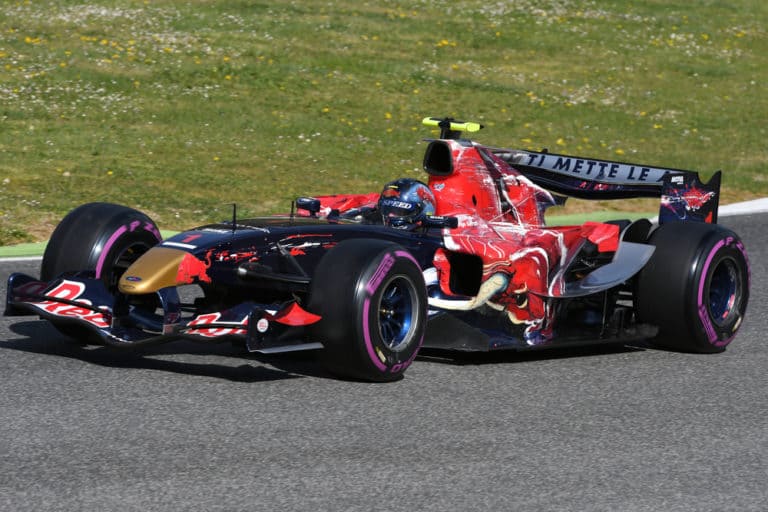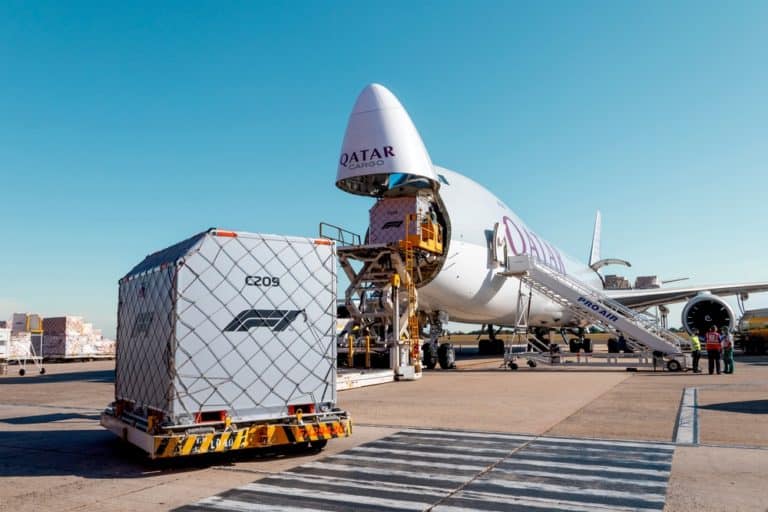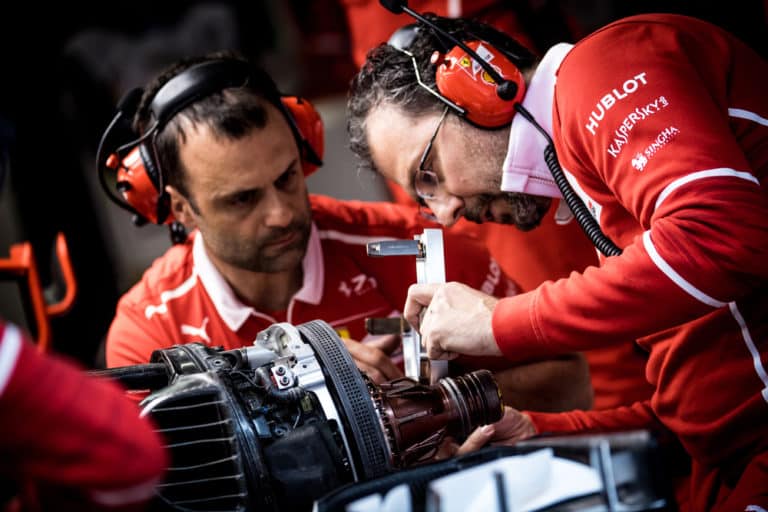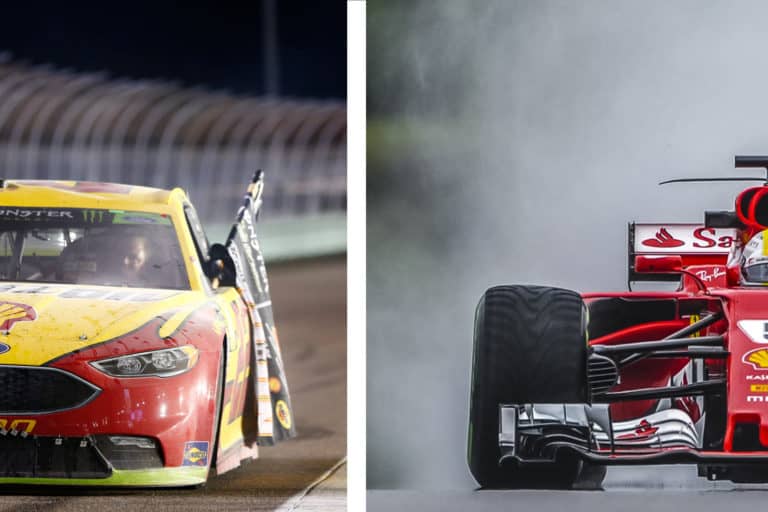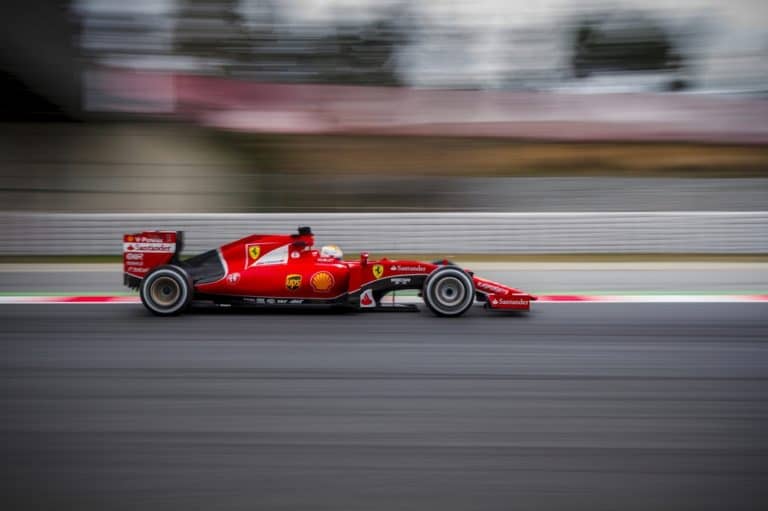Formula 1 cars are the peak of automotive engineering. They are designed and built to be the fastest, most technologically advanced, and safest cars worldwide. So, which is better? Electric cars or Formula 1 cars?
Formula 1 cars are the pinnacle of motorsport engineering and have been for decades. They are purpose-built machines designed and built from the ground up to be the fastest cars in the world. Electric cars are cheaper to maintain and operate than gas cars, emitting no pollutants.
We’re going to look at both sides of the argument and see which one comes out on top.
If you’re looking for some F1 merchandise, check out the awesome stuff at the official F1 store here.
Which Is Better? Electric Cars Or Formula 1 Cars?
Formula 1 cars are the pinnacle of motorsport engineering. They are designed and built to be the fastest, most technologically advanced, and most physically demanding race cars in the world.
Electric cars are a new technology that is rapidly gaining popularity and investment. Electric cars have many advantages over traditional petrol or diesel cars, including being cheaper to operate and maintain and producing zero emissions.
So, which is better? Electric cars or Formula 1 cars?
There are pros and cons to both. Here’s a look at how they compare.
Cost: Formula 1 cars are costly to build and maintain. Electric cars are less costly to operate and maintain since they have far fewer moving parts and don’t require expensive fuel.
Technology: Formula 1 cars are at the cutting edge of automotive technology. Electric cars are also rapidly evolving and are already benefiting from advances in battery technology.
Performance: Formula 1 cars are designed and built for speed and performance. Electric cars are not as fast as Formula 1, but they are getting closer all the time.
Emissions: Formula 1 cars produce a lot of emissions, both from the car itself and the fuel it burns. Electric cars produce no emissions and are much better for the environment.
So, there are pros and cons to both electric cars and Formula 1 cars. You must base your judgments on which type of Formula series is beneficial to the environment.
Can Electric Cars Compete In F1?
Formula E (Electric Formula) cars are not at the stage where they are capable of competing in Formula 1 just yet. Formula 1 race cars reach speeds of up to 231mph, and Formula E cars can only reach speeds of 200mph which is still far off the pace of an F1 car.
However, recent developments and innovations in Formula E technology are racing, and it is only a matter of time before Formula E cars can outperform Formula 1.
In 2018, each team required two race cars per race since a single Formula E race car could not complete a total race distance. However, Gen 2 Formula E cars solved that problem with speed, performance, and power regeneration improvements.
Gen 2 race cars increased the capacity of batteries, providing sufficient battery power for the cars to run a total race distance on a single battery charge. Gen 2 cars were quicker, with twice the range of their Gen 1 counterparts.
Gen 3 Formula E cars, due to be released in 2023, increase the regeneration power from 250kW to 600kw. This is only possible due to the addition of a 250kW motor attached to the front of the car, which is responsible for regeneration.
Formula E cars no longer require friction brakes at the rear, only at the front. Regeneration technology provides sufficient braking force to stop the car when needed.
Formula E cars are currently capable of finishing a 45-minute race on just a 52kW battery, similar to the one used on a Renault Zoe.
Gen 3 cars can now reach top speeds of 200mph while maintaining the battery range. But that’s not the only improvement of Gen 3 cars.
There is also a significant weight reduction since the weight drops from 760kg to 820kg. Gen 3 Formula E cars plan to make up to 40% of their energy from regeneration capacity during the race.
Compared to Formula 1 cars, Formula E cars are slower; however, with future improvements on Gen 4 and Gen 5 cars, that will most likely change. It is only some time before Formula E cars surpass Formula 1, and Formula 1 could be phased out and replaced by Formula E.
Are Electric Cars Faster Than F1?
Formula 1 has had several decades to evolve, develop, and improve its cars to achieve the current race pace. Regarding speed, Formula 1 cars would outpace a Formula E race car.
Although with the latest technological innovations in electric motors that power Formula E cars, newer Formula E cars can reach speeds of 280km/h, compared to 379km/h for Formula 1.
When comparing the acceleration between a Formula E car and an F1 car, Formula E cars travel from zero to 100km/h in 2.8 seconds. Formula 1 cars are only slightly quicker, with a very impressive 2.6 seconds from 0 to 100km/h.
In comparison, Formula E has been around since 2014, but these cars continue to get faster and more efficient at the current rate of innovation. How far Formula E will progress in the coming years is yet to be seen.
Formula E is not here to compete against Formula 1, nor is it designed to outperform an F1 car. Instead, its purpose is to bring about the awareness of climate change and to transition to zero-emissions mobility while pioneering new technologies for race cars that will eventually make their way to road cars.
Formula 1 has committed to carbon neutrality by 2030, and they may yet have something to learn from Formula E.
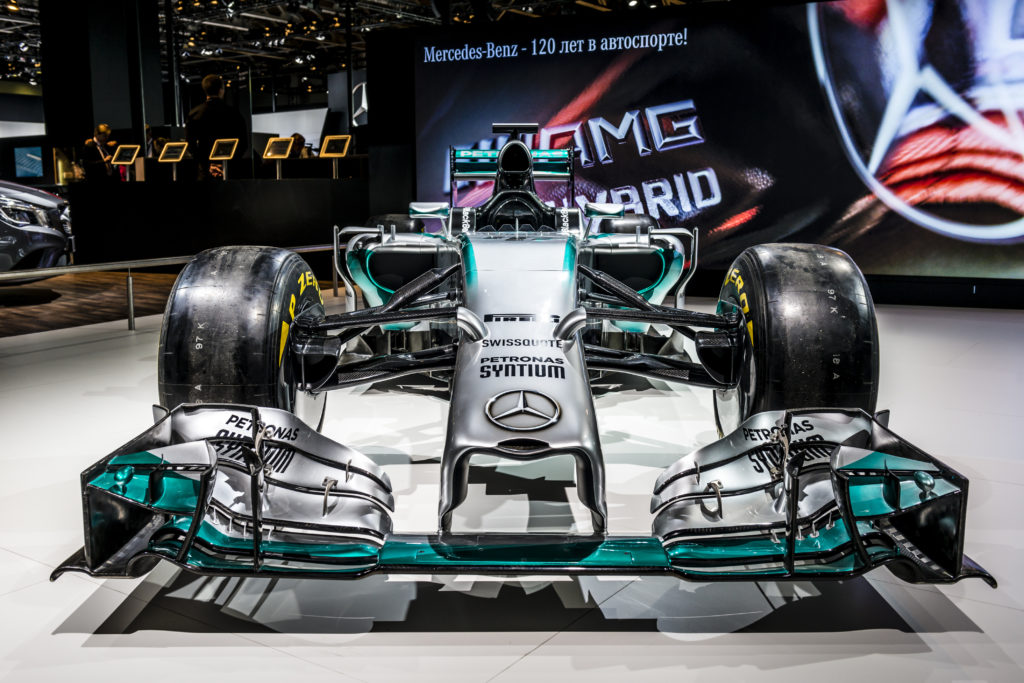
What’s The Difference Between Formula 1 And Formula E?
While Formula 1 and Formula E might often appear similar to non-racing fans, these championships are very different.
The rising popularity of Formula E has led to many comparisons with Formula 1. Still, the Formula E series, which developed out of an idea scribbled on a napkin, has a pivotal role in motorsports’ future.
To understand the differences between Formula 1 and Formula E, you must first understand the principles by which Formula E operates.
Formula E Is Fully Electric
Formula E is the first fully-electric single-seater international racing series, launched in 2014, while Formula 1 has an older history and heritage that has its origins in single-seater petrol-engine cars.
Alejandro Agag, a former Spanish politician and businessman founded the Formula E series to promote electric drivability and renewable energy solutions in major cities internationally.
Formula 1 currently is hosted in 21 different countries across the globe, while the Formula E series is hosted in 12 countries. The Formula E racing series occurs only in densely populated cities fighting against climate change to reduce air pollution.
While modern Formula 1 cars utilize a V6 hybrid turbo engine (an internal combustion engine with dual electric motors), a Formula E car uses a fully electric motor that extracts power from a battery that churns out a very impressive 250kW!
Speed is the first comparison people look at when comparing Formula E to Formula1.
While Formula E cars can accelerate as fast as an F1 car, their top speed plateaus at 280km/h, about 70km/h less than an F1 car. The slower speeds of Formula E cars do not impact or hinder the Formula E series in terms of audience interest and excitement.
Formula E Is For Low Emissions Technology
Formula E has attracted a few of the world’s largest car manufacturers, with the likes of Audi, BMW, Jaguar, Mercedes, Nissan, and Porsche, to name a few. These car manufacturers aim to accelerate the adoption of electric vehicles in the cities where Formula E travels.
Except for Mercedes, which competes in Formula 1 and Formula E, the other car manufacturers quickly realize that consumers are becoming environmentally aware. And with that, the dependence on petrol and diesel-fuelled vehicles is slowly starting to end. Formula E is the ideal platform to promote the future of low-emission vehicle technology.
Formula E Is Built For Street Circuits
Formula 1 cars are built for speed and performance and designed for racing on wider, faster, and longer circuits. On the other hand, Formula E cars are designed to be agile to race on tight, snaking street circuits shorter in race distance and narrower than the average Formula 1 circuit.
You may not hear about Formula E racing in big-name circuits like Monza, Spa, or Silverstone. Instead, Formula E races occur in other famous cities like New York, Berlin, Paris, Monaco, and even London.
Formula E Vs. Formula 1 Racing Format
Formula E races last for a duration of 45 minutes plus one lap and usually occur on a Saturday afternoon. Formula 1 races are spread over three days, starting on Friday and ending with the primary race on Sunday. Formula E race sessions are held on one day, except Friday, which is used for a thirty-minute shakedown.
But, there is also the addition of two practice sessions with a double-part qualifying session that ends with a superpole shootout, which sees the top six quickest drivers fighting for pole position.
Pole position for Formula E is not as crucial as with Formula 1. While Formula 1 pole sitters have the advantage of winning the race from the front, Formula E races are more unpredictable.
Races in Formula E are often won by drivers who have battled their way through the field to take first place in the primary race.
Formula E Pit Stops Vs. Formula 1 Pit Stops
Formula 1 pit stops during an F1 race are mandatory and require that teams enforce at least one pit stop for the duration of an F1 race. On the other hand, Formula E cannot change tires unless they encounter a puncture.
In a Formula 1 race, teams might make between two to three stops to change to different sets of tires. Formula E cars use an all-weather tire no matter the racing conditions, and they are allowed only four sets for the entire race weekend.
When Formula E initially began, a Formula E car could not complete an entire race distance without requiring to stop to change cars midway through a race. It was only recently when improvements in battery technology meant that drivers had twice the battery power to complete a race without needing to change cars.
Another characteristic of Formula E is close competitive racing. In the last Formula E season, eight different teams had a chance of winning at least one race, compared to only three teams in Formula 1.
You will see multiple overtakes in Formula E. Drivers can closely follow other cars and use mechanisms such as Attack Mode and Fanboost during a race to help overtake their opponent.
Formula E Points System Vs. Formula 1
Formula E awards point to the top ten drivers that finish in the race, the same as with Formula 1. For the first time since Formula E racing began in 2014, it holds the prestigious badge of being part of the official FIA World Championship. This means drivers can compete to win the first-ever Formula E World Champion series!
The Anatomy Of A Formula E-Car
The Formula E series promotes interest in electric cars and sustainable energy. The cars are designed to be as fast and energy-efficient as possible. This is achieved through a regenerative braking system, which captures energy that would otherwise be lost as heat and stores it in batteries.
The cars used in Formula E are all very similar. They are all single-seaters with open-wheel designs and are about 4.5 meters (15 feet) long and 2 meters (6.5 feet) wide. The cars weigh about 900 kilograms (2,000 pounds) and about 400 kilograms (880 pounds) lighter than a Formula One car.
The cars are powered by a battery pack that delivers about 200 kilowatts (270 horsepower). The battery pack is located on the car’s floor, and the weight is distributed evenly throughout the car to help with handling.
The cars can travel from 0 to 100 kilometers per hour (62 miles per hour) in about 2.8 seconds and reach a top speed of 225 kilometers per hour (140 miles per hour).
Formula E cars are designed to be as efficient as possible. The cars use regenerative braking to recapture energy that would otherwise be lost as heat. The cars also have a “push-to-pass” system that temporarily allows the driver to increase the motor’s power output.
The cars cannot have aerodynamic devices, such as wings or diffusers, that would create downforce. This keeps the cars from going too fast and the racing close.
The tires used in Formula E are specially designed to last for an entire race. They are made of a compound similar to the rubber used in Formula One tires but are not as soft. This helps to keep the tires from wearing out too quickly.
Formula E cars are very quiet due to the electric motors. This is a disadvantage, as the drivers cannot hear each other approaching, so they must rely on their spotters to communicate.
The chassis of a Formula E car is very similar to that of a Formula One car. Both cars use monocoque construction, the main difference being the materials used. Formula E cars use a carbon fiber composite, while Formula One cars use a mix of carbon fiber and aluminum.
Conclusion
It’s clear that Formula E and electric cars are the future of automotive technology. That said, it’s also clear that Formula 1 racing is here to stay. Electric cars and Formula 1 offer unique benefits that appeal to different groups of people.
Formula 1 cars are significantly faster than electric cars. They also have more powerful engines and can reach higher speeds. However, electric cars are more environmentally friendly and less expensive.
References
- https://www.keithprowse.co.uk/news-and-blog/2020/02/11/the-differences-between-formula-e-and-formula-1/
- https://www.forbes.com/sites/jamesmorris/2022/05/07/formula-1-could-be-all-electric-by-2035-says-fomula-e-boss/?sh=fcdeaf26385e
- https://www.sciencefocus.com/advertisement-feature/the-anatomy-of-a-formula-e-car/
- https://www.carmagazine.co.uk/electric/formula-e-powertrain/

